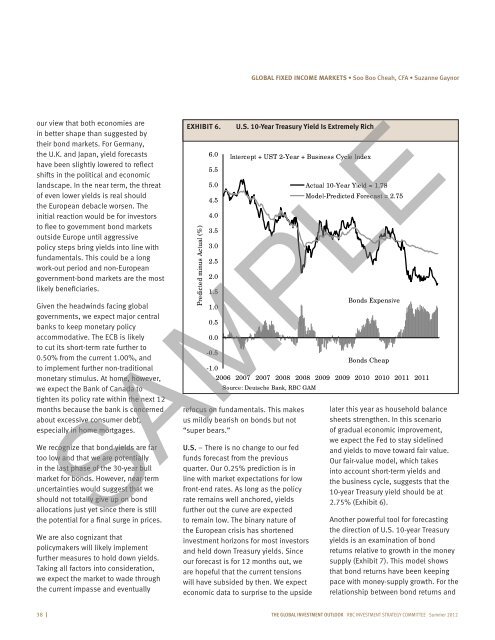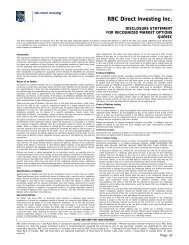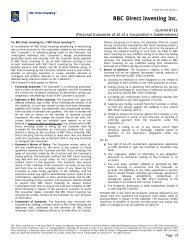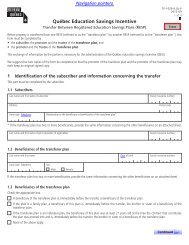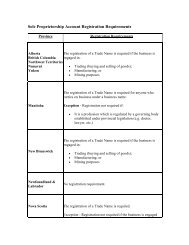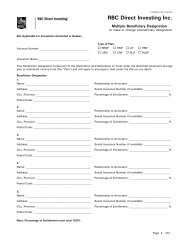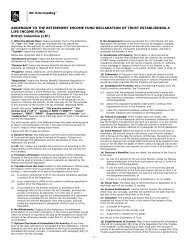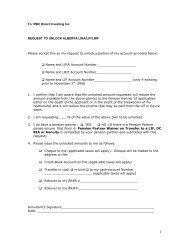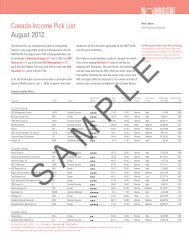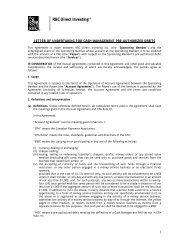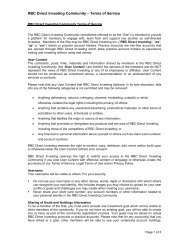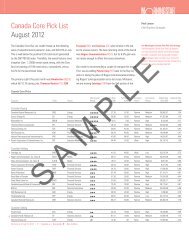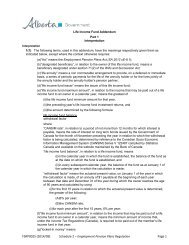View Sample PDF - RBC Direct Investing
View Sample PDF - RBC Direct Investing
View Sample PDF - RBC Direct Investing
You also want an ePaper? Increase the reach of your titles
YUMPU automatically turns print PDFs into web optimized ePapers that Google loves.
Global Fixed income markets • Soo Boo Cheah, CFA • Suzanne Gaynor<br />
our view that both economies are<br />
in better shape than suggested by<br />
their bond markets. For Germany,<br />
the U.K. and Japan, yield forecasts<br />
have been slightly lowered to reflect<br />
shifts in the political and economic<br />
landscape. In the near term, the threat<br />
of even lower yields is real should<br />
the European debacle worsen. The<br />
initial reaction would be for investors<br />
to flee to government bond markets<br />
outside Europe until aggressive<br />
policy steps bring yields into line with<br />
fundamentals. This could be a long<br />
work-out period and non-European<br />
government-bond markets are the most<br />
likely beneficiaries.<br />
Given the headwinds facing global<br />
governments, we expect major central<br />
banks to keep monetary policy<br />
accommodative. The ECB is likely<br />
to cut its short-term rate further to<br />
0.50% from the current 1.00%, and<br />
to implement further non-traditional<br />
monetary stimulus. At home, however,<br />
we expect the Bank of Canada to<br />
tighten its policy rate within the next 12<br />
months because the bank is concerned<br />
about excessive consumer debt,<br />
especially in home mortgages.<br />
We recognize that bond yields are far<br />
too low and that we are potentially<br />
in the last phase of the 30-year bull<br />
market for bonds. However, near-term<br />
uncertainties would suggest that we<br />
should not totally give up on bond<br />
allocations just yet since there is still<br />
the potential for a final surge in prices.<br />
We are also cognizant that<br />
policymakers will likely implement<br />
further measures to hold down yields.<br />
Taking all factors into consideration,<br />
we expect the market to wade through<br />
the current impasse and eventually<br />
Exhibit 6.<br />
Predicted minus Actual (%)<br />
6.0<br />
5.5<br />
5.0<br />
4.5<br />
4.0<br />
3.5<br />
3.0<br />
2.5<br />
2.0<br />
1.5<br />
1.0<br />
0.5<br />
0.0<br />
U.S. 10-Year Treasury Yield Is Extremely Rich<br />
Intercept + UST 2-Year + Business Cycle Index<br />
Actual 10-Year Yield = 1.78<br />
Model-Predicted Forecast = 2.75<br />
Bonds Expensive<br />
-0.5<br />
Bonds Cheap<br />
-1.0<br />
2006 2007 2007 2008 2008 2009 2009 2010 2010 2011 2011<br />
Source: Deutsche Bank, <strong>RBC</strong> GAM<br />
refocus on fundamentals. This makes<br />
us mildly bearish on bonds but not<br />
“super bears.”<br />
U.S. – There is no change to our fed<br />
funds forecast from the previous<br />
quarter. Our 0.25% prediction is in<br />
line with market expectations for low<br />
front-end rates. As long as the policy<br />
rate remains well anchored, yields<br />
further out the curve are expected<br />
to remain low. The binary nature of<br />
the European crisis has shortened<br />
investment horizons for most investors<br />
and held down Treasury yields. Since<br />
our forecast is for 12 months out, we<br />
are hopeful that the current tensions<br />
will have subsided by then. We expect<br />
economic data to surprise to the upside<br />
later this year as household balance<br />
sheets strengthen. In this scenario<br />
of gradual economic improvement,<br />
we expect the Fed to stay sidelined<br />
and yields to move toward fair value.<br />
Our fair-value model, which takes<br />
into account short-term yields and<br />
the business cycle, suggests that the<br />
10-year Treasury yield should be at<br />
2.75% (Exhibit 6).<br />
SAMPLE<br />
Another powerful tool for forecasting<br />
the direction of U.S. 10-year Treasury<br />
yields is an examination of bond<br />
returns relative to growth in the money<br />
supply (Exhibit 7). This model shows<br />
that bond returns have been keeping<br />
pace with money-supply growth. For the<br />
relationship between bond returns and<br />
38 I The global investment outlook <strong>RBC</strong> INVESTMENT Strategy coMMITTEE Summer 2012


